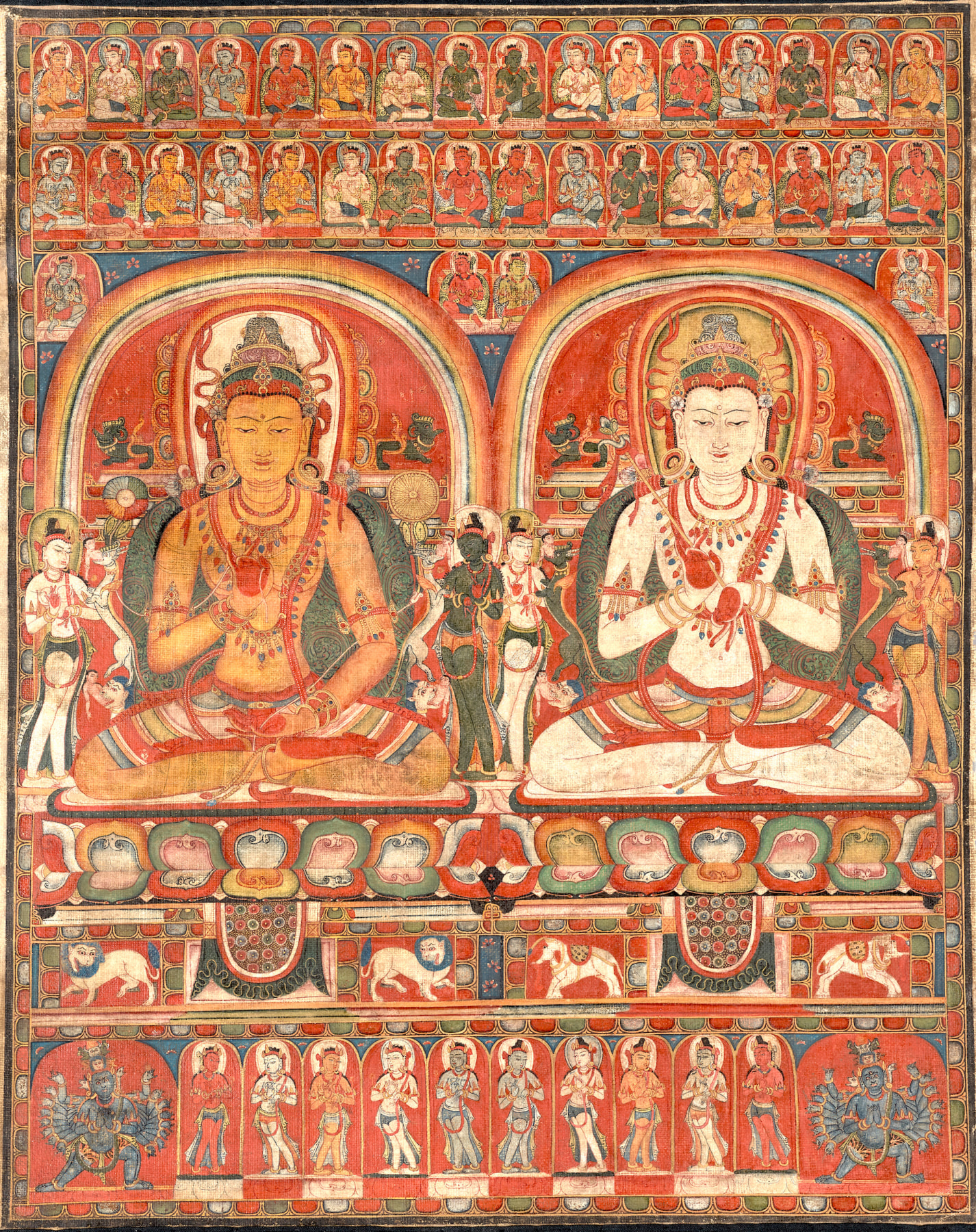
Provenance:
European Private Collection, acquired in 1999
The goddess Satrig Ersang is depicted center left with stems in each hand bearing a five-colored flowerhead at the left symbolizing the Five Heroic Syllables, and a mirror (melong) at the right, with Shenlha Okar center right holding the elephant goad (ankusha) in his right hand, each seated in vajraparyankasana on a lotus pedestal flanked by standing divinities, an arch behind with mythical animal supports, registers of seated and standing gods above and below, and nine-headed, eighteen-armed and four-legged manifestations of blue Walse Ngampa in each corner of the lower register.
This rare Tibetan thangka is from a set of at least two paintings depicting the Four Transcendent Lords of the Bon religion; compare the similar composition of another early Bon painting depicting two of the four deities[1] and another in similar style where the four deities appear together.[2]
Close stylistic comparisons are seen on thirteenth- and fourteenth-century Tibetan Buddhist paintings that interpret Indian Pala period (8th-12th centuries) traditions. Compare Satrig Ersang and Shenlha Okar’s tiered crowns and upwardly fluttering crown-ties with an Amoghasiddhi from the second half of the thirteenth century,[3] with similar earplug design, necklaces with alternating blue and red pendant gems, tripartite armbands and pendants, striped dhoti, the single anklet and the fishtail design of cloth resting on the upper surface of the pedestal, and the jeweled margins. Shenlha Okar’s triple bracelets are similar in design to the Amoghasiddhi, whereas Satrig Ersang wears the broad bangles commonly seen on goddesses in early painting and sculpture based on the Pala model; compare also textile and lotus petal designs on a circa-1300 Taklung portrait thangka in the Cleveland Museum of Art.[4] A date of late thirteenth or early fourteenth century would thus be appropriate for this unusual Tibetan painting.
Familiar Bon iconographic details include human figures in the mouths of mythical animals in the throne-back. The animals themselves differ from Buddhist tradition: the lion-headed viyala that often appear in the throne-backs of Buddhist deities are here makara-headed, and these hybrid creatures stand on snow-lions rather than elephants as is usual in a Buddhist context. And there are the distinctive animal heads of Walse Ngampa: the ubiquitous Bon manifestation of a horned garuda appears at the apex with makara heads either side, tiger, lion, and leopard heads beneath, and a bull head and snake frame the blue tutelary deity’s principal face.
Bon, Tibet’s indigenous belief system, is a high form of religious ritualism primarily concerned with righting the causes of human ailment and misfortune and coexisting with the underlying forces of the universe. It focuses on the living but has a clear sense of an afterlife and seeks to bring benefits and happiness in both this world and the world to come.
1 See Jeff Watt, https://www.himalayanart.org/items/57069
2 Ibid., 57054
3 Steven M. Kossak and Jane Casey Singer, Sacred Visions: Early Paintings from Central Tibet, New York, 1999, pp. 111-113, cat. no. 25
4 Ibid., pp. 113-115, cat. no. 26

